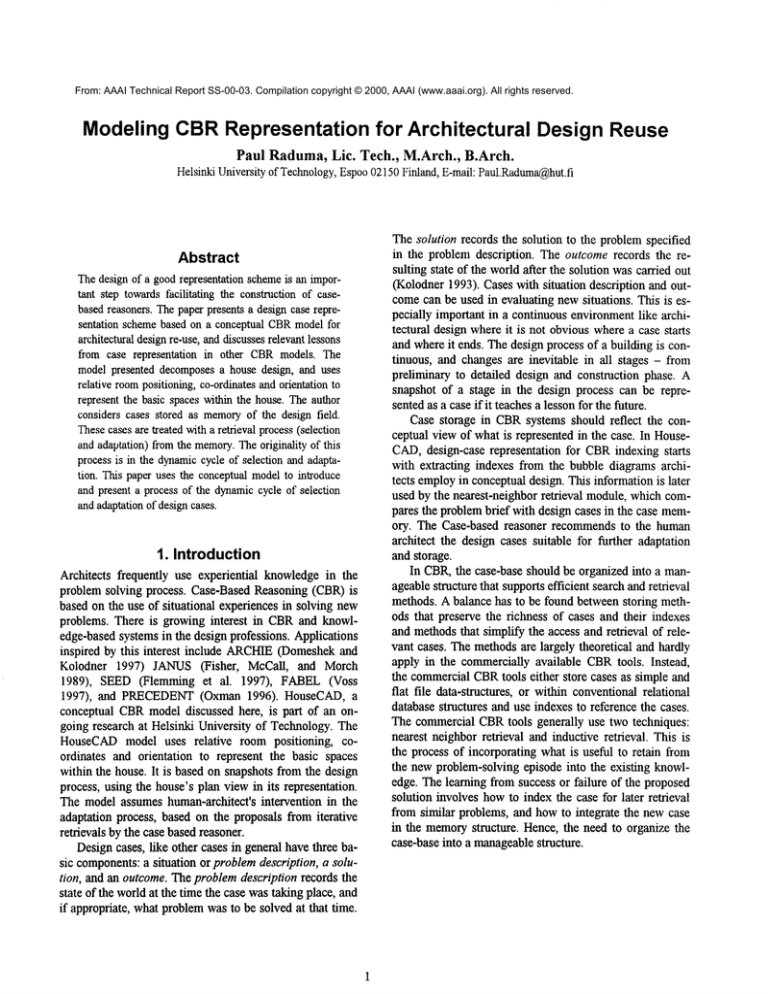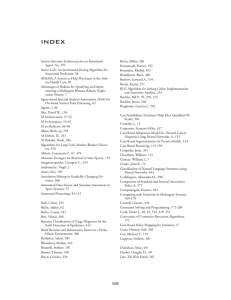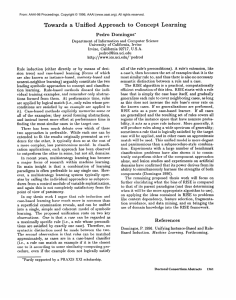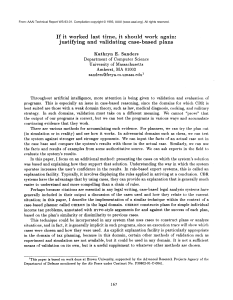
From: AAAI Technical Report SS-00-03. Compilation copyright © 2000, AAAI (www.aaai.org). All rights reserved.
ModelingCBRRepresentationfor Architectural DesignReuse
Paul Raduma, Lic. Tech., M.Arch., B.Arch.
HelsinkiUniversity of Technology,Espoo02150Finland, E-mail: Paul.Raduma@hut.fi
Abstract
The designof a goodrepresentation schemeis an important step towardsfacilitating the constructionof casebasedreasoners. Thepaperpresents a designcase representation schemebased on a conceptual CBRmodelfor
architecturaldesignre-use, anddiscussesrelevantlessons
from case representation in other CBRmodels. The
modelpresented decomposesa house design, and uses
relative roompositioning,co-ordinatesandorientation to
represent the basic spaceswithin the house. Theauthor
considers cases stored as memory
of the design field.
Thesecasesare treated witha retrieval process(selection
and adaptation)fromthe memory.
Theoriginality of this
processis in the dynamiccycle of selection and adaptation. This paper uses the conceptualmodelto introduce
and present a processof the dynamiccycle of selection
and adaptationof designcases.
1. Introduction
Architects frequently use experiential knowledgein the
problem solving process. Case-Based Reasoning (CBR)
based on the use of situational experiences in solving new
problems. There is growing interest in CBRand knowledge-basedsystems in the design professions. Applications
respired by this interest include ARCHIE
(Domeshekand
Kolodner 1997) JANUS(Fisher,
McCall, and Morch
1989), SEED(Flemming et al. 1997), FABEL(Voss
1997), and PRECEDENT
(Oxman 1996). HouseCAD,
conceptual CBRmodel discussed here, is part of an ongoing research at Helsinki University of Technology. The
HouseCADmodel uses relative room positioning, coordinates and orientation to represent the basic spaces
within the house. It is based on snapshots from the design
process, using the house’s plan view in its representation.
The model assumes human-architect’s intervention in the
adaptation process, based on the proposals from iterative
retrievals by the case basedreasoner.
Designcases, like other cases in general have three basic components:a situation or problemdescription, a solution, and an outcome. The problem description records the
state of the world at the time the case wastaking place, and
if appropriate, what problemwas to be solved at that time.
The solution records the solution to the problemspecified
in the problem description. The outcomerecords the resuiting state of the world after the solution was carried out
(Kolodner1993). Cases with situation description and outcomecan be used in evaluating new situations. This is especially important in a continuous environmentlike architectural design whereit is not obvious wherea case starts
and whereit ends. The design process of a building is continuous, and changes are inevitable in all stages - from
preliminary to detailed design and construction phase. A
snapshot of a stage in the design process can be represented as a case if it teachesa lessonfor the future.
Case storage in CBRsystems should reflect the conceptual view of what is represented in the case. In HouseCAD,design-case representation for CBRindexing starts
with extracting indexes from the bubble diagrams architects employin conceptual design. This informationis later
used by the nearest-neighbor retrieval module, which compares the problembrief with design cases in the case memory. The Case-based reasoner recommendsto the human
architect the design cases suitable for further adaptation
and storage.
In CBR,the case-base should be organized into a manageablestructure that supportsefficient search and retrieval
methods. A balance has to be found between storing methods that preserve the richness of cases and their indexes
and methodsthat simplify the access and retrieval of relevant cases. The methodsare largely theoretical and hardly
apply in the commercially available CBRtools. Instead,
the commercialCBRtools either store cases as simple and
fiat file data-structures, or within conventional relational
database structures and use indexes to reference the cases.
The commercial CBRtools generally use two techniques:
nearest neighbor retrieval and inductive retrieval. This is
the process of incorporating what is useful to retain from
the new problem-solving episode into the existing knowledge. The learning from success or failure of the proposed
solution involves howto index the case for later retrieval
from similar problems, and howto integrate the new case
in the memorystructure. Hence, the need to organize the
case-base into a manageablestructure.
2. Representing a Design Case
2.1 BubbleRepresentation
Architects love graphic representations, and often develop
their early design ideas using bubble diagrams. The
HouseCADmodel proposes case-representation
derived
from the bubble diagram. A bubble is drawn to represent
each space; dark thick lines are drawnto indicate strong
relationships, while light thin lines represent weakerrelationship (Figure 1).
i~~;!::i:iiii;~iiiii!i~i!i~!
~!iii!
{~{!i
i!i~i!i~i!i!i{
i:i!i!
i:i~{
i:i:i~ii!i~i!i!i~i!i~i!i!i!i~i~i!i!i
j j!!!i~i!i~i!i!i!i~i!i!i~i~i!i~i~i~i:i~i!!!
iii!i~i{
i:i:i~!:!{i{i!i!
i~i:!j~!!
i:i!i~i!
i:i~i!i!i!
in terms of the nameof parts; tables on which the parts
were placed; relative position of other parts; and production statistics such as start and finish times, pressure, and
temperature. In HouseCAD,the bubble diagram records
one interpretation of the brief: the problem. The case library stores design-cases: solutions that are represented
partly based on the bubble diagram.
2.2 Choosing the Design Cases
To determine the relative frequency of various spaces or
rooms in homedesigns, an analysis was done on 612 contemporary styles. These contemporary houses were taken
out of an on-line case base of 5,005 from various designers. These had two stories or more, attached garages and
had floor area of between 92 and 278 m2. Out of these 46
had floor areas of were between 255 and 275 m. This
group was first studied to determine space frequency,
which in turn woulddetermine the 32 spaces and rooms to
be considered for indexing in the HouseCAD
design-case
representation scheme (Raduma1999).
2.3 Trimmingthe CaseBase
Figure 1. Bubble Representation of a Design Scenario
In HouseCAD,
the bubble diagrams are defined by ellipses whose centers are stored as 3D co-ordinates, and
have their attributes stored in a CAD
program, and correspondto the center point of the respective space. The scenario showsa stage in the design process of the upper floor
of a two-story house. The master bedroomis represented
by B1, while B2, B3, and B4 represent the second, third
and fourth bedroomsrespectively. T1, T3 and PT represent
the master bathroom,third bathroomand patio/terrace respectively.
In ARCHIE-II- a case-based design aid for the conceptual design of buildings - for example, a bubble editor
assists the architect with conceptual design in three ways
(Griffin and Domeshek
1996). First, to improveon a representational technique architects are already using by automating editing and preserving an on-line record of their
work.Second,to help the architects describe features of the
spaces. Third, the bubbleeditor helps to form queries to the
case-based design aiding system. CBRsystems use indexes
to speed-up retrieval. A good representation schemeshould
reflect the conceptual view of what is represented in the
case. The CLAVIER
system for autoclave loading (Hennesey and Hinlde 1991, Hinlde and Toomey1994) is one of
the first commerciallyfielded CBRapplications. It has its
case representation such that each layout case is described
The selection criteria from the case-base of the 5,005 was
modified such that only single story cases with 3 or 4 bedrooms, attached garage, and with floor area of 135 to 185
ms would be retrieved. The resultant was a case base of
141, indexed 1001 to 1141. Sixteen of these cases were
removedfrom the case base if, in the author’s opinion, they
were not good cases. The final case base used for the representation scheme had 125 cases. The cases were drawn
from a total of 18 design companies.By limiting the design
cases to single story cases with 3 or 4 bedrooms,attached
garage, and with floor area of 135 to 185 ms, it makesit
possible to avoid noisy cases. It also eliminates cases that
would otherwise make the design case base too large
manlmnyenter into a case memory.
3. Decomposinga Design Case
Bubblerepresentation of a transformation of the brief is
shownin Figure 2. The scenario shows the house divided
into four quartiles - northeastern, southeastern, southwestern and northwesternquartiles. The plan north is for design
case representational and retrieval purposes only. Later
discussion showshowthe best match for this transformation compares with other case matches in the simulation
(Figure 6).
/
[
.
..<
.
r ....
,
,
t
<~::::*C2......... ",\
.::. .~ i
~
........., ’,,I".
":’::~P.~:’-
\~,
/...’"~
" .;:e..
I\ L
~,
J \ ~n
p,$~.li~i
~"’~t’rxP;
,,:.> ’:::i~::..~i:~,..~’~:"
~ ,’
::: t i
R~I ~ I
\’
\
..............
.........
...........
CG
.......
i
.
,’:~
.::::>
i ’t "~:: ....
%
.,, i ~
"~,;("
, .... ::i:~.s:.J t] "::i:i:i~4~K..Z!,.,’
"
k~/;"::.,
~.
".=~=--.
\ ~.::.<.:.:,
~>.’~::"~
:.>.:"’~
"T.x
’x , ,.I
.~i
......
.......
/
\ \.,.~:;’/,,.
<. ~. \-.,.
.......
}
’
: B2’/A;’.,
\. ,.,..-.,.,
~>J’x. ~ ..,.,~ ~,~s;’ik
.~.: /
-,=,,,
’
~"
I
previous designs, it is important to modeland analyze such
record (Raduma1999). This increases the case memory
from which iterative solutions of design problems can be
applied.
ARCHIE
uses specific space types based on courthouse
experiences. SEED
relies on two central constructs - design
units and functional units in its indexing and retrieval. In
the FABEL
domain, a case is a layout, and its features are
attribute-value pairs, or keywordsthat are associative. A
CBRtool in the architectural design domainshould aim to
develop a decision support system for architects. FABEL
for example, explores various methods for combinedreasoning and mutual support of different knowledgetypes.
HouseCAD
uses major spaces and rooms in a house, and
their orientation for indexing.
Figure 2. Space Orientation and Location: Bnef 2
4. Case Descriptors
Thecase representation is an interpretation of the brief
that calls for a detachedsingle-story, one-familyhouse, for
a retired couple. It should have three bedrooms,and an extra room that maybe used as an office. There is a spectacular view to the north. The living room, a covered
porch or deck, and one or two bedroomsshould take advantage of this view. Vehicular access to the house will be
from the southwest. It should accommodatea two-car garage, and the lady of the houseprefers it to be easily accessible to the kitchen and utilities area. Twoseparate walkin closets are required in the master bedroom
An earlier model of HouseCAD
divides the house into
four quartiles - northeastern, southeastern, southwesternor
northwestern (Raduma1999). It considers only one major
orientation or view. A space has to be oriented to the north
(N), south (S), east (E), west (W), oriented inward
non-existent (X). The modelrepresents each house plan
sets of four representation schemes, transformation by reflection of the original design-case. The transformation of
each plan yields three additional versions of the original.
The three additional cases maybe necessary if orientation
with respect to the sun, wind, slope; view and other site
constraint dictate, while other factors governinglayout remain constant. Dependingon the transformational plan retrieved, the living roomof the same design-case original
may be indexed to be in the NEQ, SEQ, SWQ,or NWQ,
all of which are correct, and mayapply in different site
contexts. Transformation by reflection or rotation is not
uncommonin site planning, and is made easy by CAD
programs. A record of such transformation is important,
and shows, after further adaptation howeach unique design
has its own unique model. Each design process includes
several design solutions that can also be represented as
cases. As designers continually re-use and modify their
The HouseCAD
represents its design cases by concentrating on the solution. This bears somesimilarity with JULIA
(Hinrichs 1992) and KRITIK
(Goel 1989), which are
design problemsolvers. JULIA’s
design task is in creating
menusolutions. Most of the problemsare too large, and
hence are broken into parts. KRITIK’s
problemdomainis
physical devices (e.g. simpleelectrical circuits), and
smaller than JULIA’s.Its functional representation shows
howthe pieces are connectedto each other, and showsthe
general effects of those connections.
~L~¢~;:le*lll>~’t¢’~l~’Ik~l’~’~ll’::,..:::.’:’’:::L
,::" :"’::’ ::: "’" :" ":: :’": ’ "...:’...i:!. "" ’~J~,~’$1~
r-d;:z
.......
-~--~,:
...........................
........
i-..................
-r~
................
::z:?;,’;:-:)~
rrs¢~
lIT
,.-.-:,’.=.:.-:~/
DHDKDIG
, ..........
~ ~IC Ix
~ ....
2~d~00r:-~,#’;’:lba’l.’’S l)Lo~ el~;B~lltu~O01~.].Ills HOT
~J~/~PA
"-" ~’--%,."t...’:...:.~,
era~Ioa’el¢oo~
a
~: ~)Iloo~
:::::::::::::::::::::::::::::::
:~:
~::::LI:::::
:i:i::::~.::i:::~
:i~:;4.-...;...;-,:-,
~..-.:~.:.e:-~,
~.:.^-..:-.-:,-.:.,:~
~,.;...J.......:.,
;....i...:~
~.....-.:..
~.~-’:..-L
J...:~,’.-:5
¯ 11::_~6.’@:.~..:..:..;.:@Z.:..,.;~.Z.
’~.;.:.:..:..:..;.;.~..:..:..:..:~..’.... ~.~.i.~;..~i~..i....:.:,,..i..~.i.~.,-.~,.i.i.~..~..i..i.i.
~.,i..i..:.,..
:.,.!..~
........................................................................
i:77l
~’~an’~9"x/~
~I~ ~~
.......
-2.
Figure 3. Design case representation
The representation schemeuses the 32 case descriptors
as discussed above. For simplicity, this schemeuses spaces
and rooms on the main floor in its representation. As
shownin Figure 3, it is however, possible to use a more
elaborate 3-floor representation scheme (Raduma1999).
This scenario shows 3-D representation of the case de3
scriptors, to show whether they represent spaces on the
basement (level 0) the main floor (level 1) or the upper
floor (level 2). This scenario is basedon a study that used
3-metre by 3-metre grid. The model decomposesa house
design, and uses relative roompositioning, co-ordinates
and orientation to represent the basic spaces within the
house.
The earlier HouseCADdesign case representation
model has two priority sets, each with 16-room or space
descriptors (Figure 3). The first set of 16 contains the descriptors for the living room (LV), master-bedroom(B1),
kitchen (KT), dinning room (DN), and main bathroom
(T1). Other are the mainstairs (S1), bedrooms2 (B2)
(B3), second bathroom (T2), family room (FR), walk-in
closet (WI), loft/balcony (LB), Deck(DK), third bathroom
(T3), Den/Library/Study/Office (DL), fourth bedroom
and patio/terrace (PT). The model uses simplified 2D coordinate system, in addition to the three planes representing
the basement,first and secondfloors. This in effect is a 3D
modelthat uses relative roompositioning to determine the
location of the respective roomswithin an eight by eight
grid. Master bedroomwidth determines the grid dimension
- one unit on the X and Y-axes, while 1 in the Z-axis refers
to level 1. Basementfloor is level 0, while the upperfloor
is level 2 in the Z-axis.
5. Retrieval and Match
Assumingthat the bubble diagram (Figure 1) is an interpretation of the brief - the problemto be solved - in terms
of the required layout, the retrieval mayyield a nearest
neighbor such as the one shown(in Figure 4). In this hypothetical example, the retrieved case has somesimilarity
in the positioning of master bedroom B1, bedrooms 2, 3
and 4, bathroomsT1 and T2. In real life scenario, HouseCADmay retrieve a design case from the case memory,
which is not the nearest neighbor. CADLayer use makesit
possible to comparethis retrieved case with the first bubble
diagram. The spatial relationship between the two bubble
diagramrepresentations is checked.
In terms of orientation, the case satisfies the desired
conditions in the master bedroom1, bedrooms2, 3, 4, second bathroomT2, and to someextent, the master bathroom
T 1. Oneother aspect, that is, the distance betweencomparable rooms or spaces is computed. The distance between
the respective mainstairs S 1, master bedroomB 1, and bedroomsB2, B3, and B4 work out to be about 4.5 m, 3 m, 2.2
m, 3.2 mand 5 m respectively. The human-architect considers that these dimensionsare too big, probably removes
the design case from the case memoryand another search
processis instituted.
After several searches from the existing case base, a
better design case is retrieved, whosebubble diagramrepresentation is again comparedwith the original bubble representation of the brief (Figures 5). The distances are much
moreacceptable (about 0.9 m, 1.8 m, 0.8 m, 2.1 m, and 2.5
m). Using weighted nearest-neighbor retrieval technique,
the latter distances (2.1 m, 2.5m), that betweenrespective
bedrooms 3 and 4, HouseCAD
advises that the retrieved
case is acceptable for adaptation.
In the current HouseCAD
representation scheme, each
design case is transformedby reflection and/or by rotation.
This transformation yields an additional 7 design case representations. There are two alternatives: Each of the 125
design cases with 8 design case representations and stored
in the case-base, or a secondalternative of representing the
brief with additional 7 design case representations. The
latter has been used in the simulation. Hence, we have a
total of 8 design case representations namely the BRIEF,
BRIEF2, 3, 4, 5, 6, 7 and 8. The design Brief 7, for example, refers to the brief mirroredalong X-axis with 90° rotation.
Each of these representations was matchedwith each of
the 125 design cases in the case base. The HouseCAD
representation schemeuses the 32 case descriptors discussed
in step 4 above. Ananalysis of the 125 design cases revealed that the first 8 descriptors accountedfor 985 out of
2,106 instances (46.8%). The next 8 descriptors accounted
for 796 instances (37.8%)and the last 16 accountedfor 325
(15.4%). This information was used in weighedmatching.
Hencedeign case 1,082 has a 23%match with the brief. It
has 2 matches using the first 8 descriptors, 1 match with
the next 8, and one matchwith the last 16 case descriptors.
I
¯ i~.;::ii~
. ":ii.......
.i........
i.i.......
i.. :!..( ........ ~....!.:...i..~.i..~i...i....i...:.i
N
illllllllll
::::::::::::::::::::::::::::::::::::::
......
__:::::::::::::::::::::::::::::::::::
......~..........
z
Figure 5. Case Comparison
There was no match at all in 16 out of the 125 cases.
Brief 3, a transformationof the brief mirrored along X-axis
had an average match of 6%. Brief 4, a transformation of
the brief mirrored along Y-axis &with 90° rotation had an
average match of 5.6%. The best four retrievals had
matches of 18%, 16%, 16% and 16%. There was no match
at all in 39 out of the 125cases Brief 5, a transformationof
the brief mirrored along X-axis had an average match of
5.9%. Brief 6, a transformation of the brief with 90° rotation had an average match of 4.3%. Brief 7, a transformation of the brief mirrored along X-axis with 90° rotation
had an average match of 6.1%. The best four retrievals had
matches of 23%, 23%, 17%and 16%. There was no match
at all in 42 out of the 125 cases. Brief 8, a transformation
of the brief with 180° rotation had an average match of
3.4%.
BRIEF 1
max. match total
18
weight
100
CASE case match %
1065
3 4
0
39
1074 3 3
0 34
1026
2 3
0
28
1047
2 3
0
28
1052
1 4
0
26
1007
3 1
0
:25
1008
3 1
0
125
1009
3 1
0
125
1086
3 1
0
125
1082
2 1
1 23
1006
2 2
0
23
0
1121
2 2
23
1028
1 2
1 21
1010
1 3
0
21
1032
1 3
0
21
Figure 6. Case Retrieval
1122 (37% match)
The brief has a total of 18 case descriptors distributed
as follows: 7 out of 8 in the first set; 7 out of 8 in the second set, and 3 out of 16 in the third set. Usingthe design
case representation of the brief, there was an average
match of 10.9%. The best four retrievals had matches of
39%, 34%, 28%and 28%. There was no match at all in 18
out of the 125 cases. The design Brief 2, a transformation
of the brief - mirrored along Y-axis had an average match
of 12.7%- better than the original brief. The best four retrievals had matches of 37%, 37%, 36%and 35%(Figure
6, Table1).
BRIEF 2
max. match
47
CASEcase
1102 2
1122 2
1123 1
1037 3
1062 3
1063 3
1075 3
1106 1
1112 1
1107 1
1051 3
1081 2
1104 2
1068 1
1101 1
match
5
0
5
0
4
2
2
1
3
0
3
0
3
0
4
1
4
1
5
0
0
2
3
0
3
0
3
1
3
1
total
18
100
%
37
37
36
35
34
34
34
31
31
3O
3O
28
28
26
26
Table 1. Best 15 matchesin Brief I and Brief2
The result of the simulation, especially of the Brief and
Brief 2 is significant. It should be noted that the case base
was restricted to singe story houses with 3 or four bedrooms and an attached garage. Each of the 32 case descriptors can be represented to be in any of the four quartiles (NEQ,SEQ, SWQand NWQ).ff represented in each
the four quartiles, the case descriptor maybe represented to
open to one of the nine orientations: the north, northeast,
east, southeast, south, southwest, west, northwest, or inward. This implies that there are 4*9 alternatives in representing each descriptors, or 36 possibilities. The brief had
18 spaces, each of which has 36 orientation alternatives.
5
The numberof combinations and permutations is huge. On
average, the 125 design cases had a little less than 18 case
descriptors, but somehad as little as 14 (case 1022).
achieve an exact match, the correct design case should
have 18 case descriptors in a specific orientation. The
chance for getting an exact match in any of the 125 design
cases is close to zero. The success of our case base is due
to the fact that only cases relevant to the narrow domain
(singe story houses with 3 or four bedroomsand an attached garage) was used. Further the cases were represented such that the entrance lobby (and front porch) were
oriented to the south, thus limiting any randomlocation of
the lobby (LB) and in somecases, the front porch (C1)
the south.
5. Adaptation Question
Adaptation is widely accepted as the biggest challenge in
the CBRprocess. It is yet to be seen if case-based reasoners in the design domainwill develop as autonomoussystemsthat carry, out retrieval, adaptation and evaluation process by themselves. Wehave a lot to learn from, for example, CHEF, JULIA, PLEXUS, CASEY, PROTOS and
HYPO,case-based reasoners considered by some to be
autonomous systems (Leake, 1996). Human-machinesystem that works along with architects to solve design problems or interpret design scenarios is proposed in the
HouseCADmodel. CLAVIER,considered successful in
the design domainby most CBRscientists, was designed to
adapt autoclave layouts, but the engineers on the ground
did not like the adaptation facility. Theyopted to adapt the
layouts themselves, using CLAVIER
to check that their
humanadaptation will not repeat a failed autoclave layout.
The adapted design-case, from its case representation
or indexing, is comparedwith other indexes in the case
memory.In one scenario, one design case comparedvery
closely with the original bubble diagram- the brief (Figure
1), especially the relative position and orientation of master
bedroomB1. It also comparedvery well with the adjacent
bedroomB3, bedroomB4 with its "western" orientation,
position of the patio/terrace PT and the position of the
master bathroom T1. The human-architect mayaccept this
as the final retrieval from whichminorand final adaptation
will be made.The architect mayalternatively retrieve another case, compareit with the original bubble diagram,
transformit, and adapt it. In order to satisfy the constraints
set out earlier, the architect converts the master bedroom
B1 to B2, then enlarges B2 to the size of B1, and converts
the master bathroomT1 to patio/terrace PT. The resultant
goes through transformationby reflection to yield a total of
four newdesigns. This is stored as part of the case-base
(Figures7, 8).
The adaptation method in HouseCADis not autonomous, but based on the humanarchitect’s intervention. The
methodis a combination of specialized search and casebased substitution. Both auxiliary knowledgestructures
and case memoryare queried, and specialized search heuristics are used to guide the memorysearch. Case-based
substitution uses other cases to suggest substitutions as in
CLAVIERand JULIA.
6. Discussion
Architectural design re-use is one avenue of CBRresearch
that can be of direct benefit in housing design for large
population groups. The traditional white table approach to
low-incomehousing design cannot yield user-specific designs if there is limited time and financial resources committed to architectural design. The white table approachin
6
housing design for such large population groups mayresult
in duplicating inappropriate prototypes in hundreds or
thousands, not suited to varying user profiles. The design
of housing has to be seen from the design of the individual
unit and as part of a larger urban planning project. It is
therefore useful to comparelessons from case-based planning. In the design and planning of housing, CBRas a
knowledge-basedsystem is feasible as a knowledgeassistant, and an intelligent consultant (Yeh and Shi 1999).
case-based planning (CBP), previously generated plans are
stored as cases in memoryand can be reused to solve
similar planning problemsin the future. CBPcan save considerable time over planning from scratch (generative
planning), thus offering a potential (heuristic) mechanism
for handling intractable problems. One drawback of CBP
systems has been the need for a highly structured memory
that requires significant domainengineering and complex
memoryindexing schemes to enable efficient case retrieval. This problem can be alleviated, like in CAPER
(Hendler 1995), using a CBPsystem that is based on
massively frame-based AI language that can do extremely
fast retrieval of complexcases from a large, non-indexed
memory.
The performance of Case-Based Reasoners, like other
intelligent systems, dependson factors including inherent
design decisions and domaincharacteristics. In the architectural design domain, breaking the task in to small manageable pieces best solves the problem. This does not preclude looking at the big picture- howthe individual parts
relate to each other and with the outside world. The
HouseCADmodel proposes a design case representation
model in the domainof residential architecture based on
the decompositionof a house design, and the use of relative roompositioning, co-ordinates and orientation to represent the basic spaces within the house.
7. References
¯ Domeshek,E., and Kolodner, J. 1997. The Designer’s
Muse. In lssues and Applications of Case-BasedReasoning in Design, M. L. Maher and Pu, P. eds.
Hillsdale, N.J: LawrenceErlbaumAssociates: 11-38.
¯ Fisher, G., McCall, R., and Morch, A. 1989. Design
Environments for Constructive and Argumentative
Design. In, Proceedings, HumanFactors in Computing Systems Conference, NewYork: ACMPress: 269275.
¯ Flemming, U., Aygen, Z., Coyne, R., and Snyder J.,
1997. Case-Based Design in a Software Environment
that supports the Early Phases in Building Design. In
lssues and Applications of Case-Based Reasoning in
Design: 61-86.
¯ Griffith
A.L. and Domeshek, E. 1996. Indexing
Evaluations of Buildings to Aid Conceptual Design. In
Leake, D. B., ed. Case-BasedReasoning. Experiences,
Lessons & Future Directions Cambridge, MA:AAAI
Press/MIT Press
¯ Goel, A. 1989. Integration of case-based reasoning and
model-based reasoning for adaptive problem solving.
Ph.D. dissertation, Dept. of Computerand Information
Science, The OhioState University.
¯ Hendler, J. A. 1995. Evaluating the CAPER
Planning
System, Proceedings, Israeli Symposiumon Artificial
Intelligence, Jerusalem, Israel, Jan 1995.
¯ Hennesey, D. and Hinkle, D. 1991. Initial Results from
Clavier: A case-based autoclave loading assistant. In
Proceedings of the DARPACase-Based Reasoning
Workshop, edited by R. Bareiss. San Francisco:
Morgan KauffmanPublishing.
¯ Hinkle, D., & Toomey, C. 1994. Clavier: Applying
Case-Based Reasoning to CompositePart Fabrication.
In Innovative Applications of Artificial Intelligence 6,
54-62. Cambridge, MA:AAAIPress/MIT Press.
¯ Hinrichs, T.R. 1992. Problem Solving in open worlds.
A Case Study in Design. Northvale, NJ: Erlbaum.
¯ Kolodner, J. 1993. Case-Based Reasoning. San Mateo,
CA: Morgan Kanfmann.
¯ Leake, D. B. 1996. CBRin Context: The Present and
Future. In Leake, D. B. ed.. Case-BasedReasoning.
Experiences, Lessons & Future Directions Cambridge,
MA:AAAIPress/MIT Press
¯ Oxman,R. E. 1996. Case-based design support: supporting architectural composition through precedent
libraries. Journal of Architectural and Planning Research 13, 242-255.
¯ Raduma, P. 1999. Designing a CBRRepresentation
Scheme for Architectural Design Reuse. Arpakannus
1/99, Newsletter of the Finnish Artificial Intelligence
Society, Special Issue on the IJCAI’99affiliate event
Networks’99,Espoo, Finland August 8-19, 1999.
¯ Voss, A. 1997. Case Design Specialists in Fabel. In
Maher M.L& Pu, P. eds. lssues and Applications of
Case-Based Reasoning in Design, Lawrence Erlbaum
¯ Yeh, A. G. O., and Sift, X. 1999. Applying case-based
reasoning to urban planning. A new planning-support
system tool. Environment and Planning B: Planning
and Design 1999, volume26 pages 101-115.






